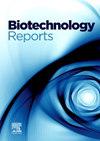Assessment of microbial antagonistic activity and Quorum Sensing Signal Molecule (Cyclopeptides-DKPs and N-Acyl Homoserine Lactones) detection in bacterial strains obtained from avocado thrips (Thysanoptera: Thripidae)
Q1 Immunology and Microbiology
引用次数: 0
Abstract
The control of avocado pests and diseases heavily relies on the use of several types of pesticides, some of which are strictly monitored or not internationally accepted. New sources of bioactive molecules produced by phytopathogen-inhibiting microorganisms offer an excellent alternative for the control of pests and diseases. This study explores the potential antagonistic action against phytopathogenic microorganisms, using bacterial strains obtained from avocado thrips. In addition, we detected and identified quorum sensing (QS) signaling molecules that are related to virulence factors and antibiotic production. The results showed that Bacillus, Pantoea, and Serratia strains exhibited antagonism against five fungal phytopathogens. Additionally, some bacteria also produce specific signaling molecules like N-3-(oxododecanoyl)-l-homoserine lactone (OdDHL), N-(3-oxo)-hexanoyl l-HL (OHHL), 4‑hydroxy-2-heptylquinoline (HHQ) or 2-heptyl-3,4-dihydroxyquinoline (PQS, Pseudomonas quinolone signal), cyclo(L-Phe-l-Pro), and cyclo(L-Pro-l-Tyr, which might give them antimicrobial properties. This research explores the biotechnological potential of these bacteria in fighting the diseases affecting avocados in Colombia.
牛油果蓟马微生物拮抗活性评价及群体感应信号分子(环肽- dkps和n -酰基同型丝氨酸内酯)检测
牛油果病虫害的控制严重依赖于几种农药的使用,其中一些农药受到严格监控或不被国际认可。植物病原菌抑制微生物产生的生物活性分子的新来源为防治病虫害提供了一个很好的选择。本研究利用从鳄梨蓟马中获得的细菌菌株,探讨了对植物病原微生物的潜在拮抗作用。此外,我们检测并鉴定了与毒力因子和抗生素产生相关的群体感应(QS)信号分子。结果表明,芽孢杆菌、Pantoea和Serratia菌株对5种真菌植物病原体具有拮抗作用。此外,一些细菌还产生特定的信号分子,如N-3-(氧十二烷基)-l-丝氨酸内酯(OdDHL)、N-(3-氧)-己醇基l-HL (OHHL)、4-羟基-2-庚基喹啉(HHQ)或2-庚基-3,4-二羟基喹啉(PQS,喹诺酮假单胞菌信号)、环(l- ph -l- pro)和环(L-Pro-l-Tyr),这些信号分子可能赋予它们抗菌特性。这项研究探索了这些细菌在对抗影响哥伦比亚鳄梨的疾病方面的生物技术潜力。
本文章由计算机程序翻译,如有差异,请以英文原文为准。
求助全文
约1分钟内获得全文
求助全文
来源期刊

Biotechnology Reports
Immunology and Microbiology-Applied Microbiology and Biotechnology
CiteScore
15.80
自引率
0.00%
发文量
79
审稿时长
55 days
期刊介绍:
Biotechnology Reports covers all aspects of Biotechnology particularly those reports that are useful and informative and that will be of value to other researchers in related fields. Biotechnology Reports loves ground breaking science, but will also accept good science that can be of use to the biotechnology community. The journal maintains a high quality peer review where submissions are considered on the basis of scientific validity and technical quality. Acceptable paper types are research articles (short or full communications), methods, mini-reviews, and commentaries in the following areas: Healthcare and pharmaceutical biotechnology Agricultural and food biotechnology Environmental biotechnology Molecular biology, cell and tissue engineering and synthetic biology Industrial biotechnology, biofuels and bioenergy Nanobiotechnology Bioinformatics & systems biology New processes and products in biotechnology, bioprocess engineering.
 求助内容:
求助内容: 应助结果提醒方式:
应助结果提醒方式:


